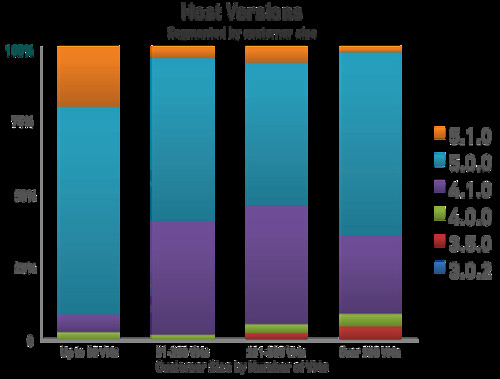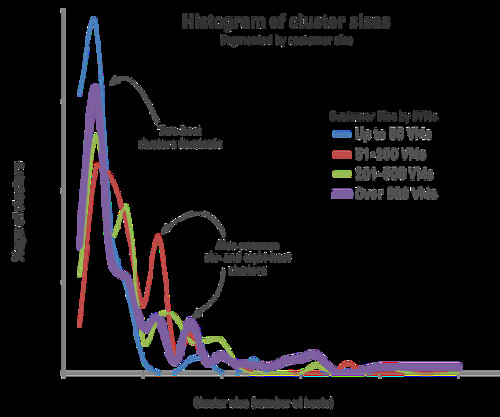The state of vSphere clustering
By Irfan Ahmad
Some of my colleagues at CloudPhysics and I spent years at VMware and were lucky to have participated in one of the most rapid transformations in enterprise technology history. A big part of that is VMware’s suite of clustering features. I worked alongside Carl Waldspurger in the resource management team at VMware that brought to the world the ESX VMkernel CPU and memory schedulers, DRS, DPM, Storage I/O Control and Storage DRS among other features. As a result, I am especially interested in analyzing and improving how IT organizations use clustering.
Over a series of blog posts, I’ll try to provide a snapshot of how IT teams are operationalizing vSphere. One of my co-founders, Xiaojun Liu and I performed some initial analysis on the broad community dataset that is continually expanding as more virtualization engineers securely connect us to their systems.
First, we segmented our analysis based on customer size. The idea was to isolate the effect of various deployment sizes including test labs, SMBs, commercial and large enterprise, etc. Our segmentation was in terms of total VMs in customer deployments and divided up as: 1-50 VMs, 51-200, 201-500, 501-upwards. Please let us know if you believe an alternative segmentation would warrant better analysis.
Initially we compared various ESX versions deployed in the field. We found ESXi 5.0 already captured the majority of installations in large deployments. However, 4.0 and 3.5 versions continue to be deployed in the field in small numbers. Version 4.1, on the other hand, continues to be more broadly deployed. If you are still using 4.1, 4.0, and 3.5, we recommend upgrading to 5.0 which provides greatly improved HA clustering, amongst many other benefits. This data shows the 5.0 version has been broadly adopted by our peers and is user-verified production ready.

Next, we looked at cluster sizes. A key question for VMware product managers was often, “How many hosts are there in a typical cluster?” This was a topic of considerable debate, and it is critically important to know when prioritizing features. For example, how much emphasis should go into scalability work for DRS.
For the first time, CloudPhysics is able to leverage real customer data to provide answers. The highest frequency cluster size is two hosts per cluster for customers with greater than 500 VMs. Refer to the histogram. This result is surprisingly low and we do not yet know all the contributing reasons, though we can speculate on some of the causes. These may be a combination of small trainiång clusters, dedicated clusters for some critical applications, Oracle clustering license restrictions, or perhaps a forgotten pair of older servers. Please tell us why you may have been keeping your clusters small.

Despite the high frequency of two-host clusters, we see opportunities for virtualization architects to increase their resource pooling. By pooling together hosts into larger clusters, DRS can do a much better job at placement and providing resource management. That means real dollars in savings. It also allows for more efficient HA policy management since the absorption of spare capacity needed for infrequent host failures is now spread out over a larger set of hosts. Additionally, having fewer clusters makes for fewer management objects to configure, keep in sync with changing policies, etc. This reduces management complexity and makes for a safer and more optimized environment.
Several caveats arise with regard to the above findings. First is potential sample bias. For instance, it might be the case that companies using CloudPhysics are more likely to be early adopters and that early adopters might be more inclined to upgrade to ESX 5.0 faster. Another possible issue is imbalanced dataset composition. It might be that admins are setting up small training or beta labs, official test & development, and production environments mixed in the same environment thus skewing the findings.
CloudPhysics is the first to provide a method of impartially determining answers based on real customer data, in order to dampen the controversy.

Xiaojun and I will continue to report back on these topics as the data evolves. In the meantime, the CloudPhysics site is growing with new cards being added weekly. Each card solves daily problems that virtualization engineers have described to us in our Community Cards section. I hope you will take the time to send us your feedback on the CloudPhysics site.